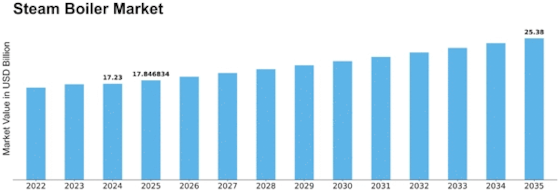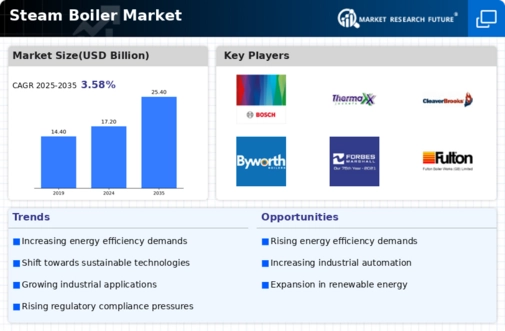-
EXECUTIVE SUMMARY
-
SCOPE OF THE REPORT
-
MARKET DEFINITION
-
SCOPE OF THE STUDY
- DEFINITION
- RESEARCH OBJECTIVE
- ASSUMPTIONS
- LIMITATIONS
-
RESEARCH PROCESS
- PRIMARY RESEARCH
- SECONDARY RESEARCH
-
MARKET SIZE ESTIMATION
-
FORECAST MODEL
-
MARKET LANDSCAPE
-
PORTER’S FIVE FORCES ANALYSIS
- THREAT OF NEW ENTRANTS
- BARGAINING POWER OF BUYERS
- THREAT OF SUBSTITUTES
- SEGMENT RIVALRY
- BARGAINING POWER OF BUYERS
-
VALUE CHAIN/SUPPLY CHAIN ANALYSIS
-
MARKET DYNAMICS
-
INTRODUCTION
-
MARKET DRIVERS
-
MARKET RESTRAINTS
-
MARKET OPPORTUNITIES
-
MARKET TRENDS
-
GLOBAL STEAM BOILER MARKET, BY TYPE
-
INTRODUCTION
-
WATER-TUBE BOILER
- MARKET ESTIMATES & FORECAST, 2023-2032
- MARKET ESTIMATES & FORECAST BY REGION, 2023-2032
-
FIRE-TUBE BOILER
- MARKET ESTIMATES & FORECAST, 2023-2032
- MARKET ESTIMATES & FORECAST BY REGION, 2023-2032
-
GLOBAL STEAM BOILER MARKET, BY COMPONENT
-
INTRODUCTION
-
BOILER
- MARKET ESTIMATES & FORECAST, 2023-2032
- MARKET ESTIMATES & FORECAST BY REGION, 2023-2032
-
ECONOMIZER
- MARKET ESTIMATES & FORECAST, 2023-2032
- MARKET ESTIMATES & FORECAST BY REGION, 2023-2032
-
SUPERHEATER
- MARKET ESTIMATES & FORECAST, 2023-2032
- MARKET ESTIMATES & FORECAST BY REGION, 2023-2032
-
AIR PREHEATER
- MARKET ESTIMATES & FORECAST, 2023-2032
- MARKET ESTIMATES & FORECAST BY REGION, 2023-2032
-
FEED PUMP
- MARKET ESTIMATES & FORECAST, 2023-2032
- MARKET ESTIMATES & FORECAST BY REGION, 2023-2032
-
GLOBAL STEAM BOILER MARKET, BY FUEL
-
INTRODUCTION
-
COAL-FIRED STEAM BOILER
- MARKET ESTIMATES & FORECAST, 2023-2032
- MARKET ESTIMATES & FORECAST BY REGION, 2023-2032
-
GAS-FIRED STEAM BOILER
- MARKET ESTIMATES & FORECAST, 2023-2032
- MARKET ESTIMATES & FORECAST BY REGION, 2023-2032
-
OIL-FIRED STEAM BOILER
- MARKET ESTIMATES & FORECAST, 2023-2032
- MARKET ESTIMATES & FORECAST BY REGION, 2023-2032
-
BIOMASS-FIRED STEAM BOILER
- MARKET ESTIMATES & FORECAST, 2023-2032
- MARKET ESTIMATES & FORECAST BY REGION, 2023-2032
-
ELECTRIC STEAM BOILER
- MARKET ESTIMATES & FORECAST, 2023-2032
- MARKET ESTIMATES & FORECAST BY REGION, 2023-2032
-
GLOBAL STEAM BOILER MARKET, BY END-USER
-
INTRODUCTION
-
POWER GENERATION
- MARKET ESTIMATES & FORECAST, 2023-2032
- MARKET ESTIMATES & FORECAST BY REGION, 2023-2032
-
OIL & GAS
- MARKET ESTIMATES & FORECAST, 2023-2032
- MARKET ESTIMATES & FORECAST BY REGION, 2023-2032
-
CHEMICAL
- MARKET ESTIMATES & FORECAST, 2023-2032
- MARKET ESTIMATES & FORECAST BY REGION, 2023-2032
-
PROCESS INDUSTRY
- MARKET ESTIMATES & FORECAST, 2023-2032
- MARKET ESTIMATES & FORECAST BY REGION, 2023-2032
-
PRIMARY METAL
- MARKET ESTIMATES & FORECAST, 2023-2032
- MARKET ESTIMATES & FORECAST BY REGION, 2023-2032
-
GLOBAL STEAM BOILER MARKET, BY REGION
-
INTRODUCTION
-
NORTH AMERICA
- MARKET ESTIMATES & FORECAST, 2023-2032
- MARKET ESTIMATES & FORECAST BY TYPE, 2023-2032
- MARKET ESTIMATES & FORECAST BY COMPONENT, 2023-2032
- MARKET ESTIMATES & FORECAST BY FUEL, 2023-2032
- MARKET ESTIMATES & FORECAST BY END-USER, 2023-2032
- US
- CANADA
- MEXICO
-
EUROPE
- UK
- FRANCE
- GERMANY
- ITALY
- RUSSIA
- REST OF EUROPE
-
ASIA-PACIFIC
- CHINA
- JAPAN
- INDIA
- AUSTRALIA
- SOUTH KOREA
- REST OF ASIA-PACIFIC
-
MIDDLE EAST & AFRICA
- SAUDI ARABIA
- UAE
- IRAN
- SOUTH AFRICA
- REST OF MIDDLE EAST & AFRICA
-
SOUTH AMERICA
- BRAZIL
- ARGENTINA
- REST OF SOUTH AMERICA
-
COMPETITIVE LANDSCAPE
-
COMPANY PROFILE
-
GENERAL ELECTRIC (US)
- COMPANY OVERVIEW
- PRODUCTS/SERVICES OFFERING
- FINANCIAL OVERVIEW
- KEY DEVELOPMENTS
- STRATEGY
- SWOT ANALYSIS
-
BOSCH (GERMANY)
- COMPANY OVERVIEW
- PRODUCTS/SERVICES OFFERING
- FINANCIAL OVERVIEW
- KEY DEVELOPMENTS
- STRATEGY
- SWOT ANALYSIS
-
THERMAX (INDIA)
- COMPANY OVERVIEW
- PRODUCTS/SERVICES OFFERING
- FINANCIAL OVERVIEW
- KEY DEVELOPMENTS
- STRATEGY
- SWOT ANALYSIS
-
CLEAVER-BROOKS (US)
- COMPANY OVERVIEW
- PRODUCTS/SERVICES OFFERING
- FINANCIAL OVERVIEW
- KEY DEVELOPMENTS
- STRATEGY
- SWOT ANALYSIS]
-
BYWORTH BOILERS (US)
- COMPANY OVERVIEW
- PRODUCTS/SERVICES OFFERING
- FINANCIAL OVERVIEW
- KEY DEVELOPMENTS
- STRATEGY
- SWOT ANALYSIS
-
DOOSAN HEAVY INDUSTRIES & CONSTRUCTION (SOUTH KOREA)
- COMPANY OVERVIEW
- PRODUCTS/SERVICES OFFERING
- FINANCIAL OVERVIEW
- KEY DEVELOPMENTS
- STRATEGY
- SWOT ANALYSIS
-
FORBES MARSHALL (INDIA)
- COMPANY OVERVIEW
- PRODUCTS/SERVICES OFFERING
- FINANCIAL OVERVIEW
- KEY DEVELOPMENTS
- STRATEGY
- SWOT ANALYSIS
-
FULTON BOILER (US)
- COMPANY OVERVIEW
- PRODUCTS/SERVICES OFFERING
- FINANCIAL OVERVIEW
- KEY DEVELOPMENTS
- STRATEGY
- SWOT ANALYSIS
-
PARKER BOILER (US)
- COMPANY OVERVIEW
- PRODUCTS/SERVICES OFFERING
- FINANCIAL OVERVIEW
- KEY DEVELOPMENTS
- STRATEGY
- SWOT ANALYSIS
-
RENTECH BOILERS (US)
- COMPANY OVERVIEW
- PRODUCTS/SERVICES OFFERING
- FINANCIAL OVERVIEW
- KEY DEVELOPMENTS
- STRATEGY
- SWOT ANALYSIS
-
THERMODYNE ENGINEERING SYSTEMS (INDIA)
- COMPANY OVERVIEW
- PRODUCTS/SERVICES OFFERING
- FINANCIAL OVERVIEW
- KEY DEVELOPMENTS
- STRATEGY
- SWOT ANALYSIS
-
LIST OF TABLES
-
GLOBAL STEAM BOILER MARKET: BY REGION, 2023-2032
-
NORTH AMERICA: STEAM BOILER MARKET: BY COUNTRY, 2023-2032
-
EUROPE STEAM BOILER MARKET: BY COUNTRY, 2023-2032
-
ASIA-PACIFIC STEAM BOILER MARKET: BY COUNTRY, 2023-2032
-
MIDDLE EAST & AFRICA STEAM BOILER MARKET: BY COUNTRY, 2023-2032
-
SOUTH AMERICA STEAM BOILER MARKET: BY COUNTRY, 2023-2032
-
GLOBAL STEAM BOILER, BY TYPE, BY REGIONS, 2023-2032
-
NORTH AMERICA: STEAM BOILER MARKET, BY TYPE, BY COUNTRY, 2023-2032
-
EUROPE STEAM BOILER MARKET, BY TYPE, BY COUNTRY, 2023-2032
-
ASIA-PACIFIC STEAM BOILER MARKET BY TYPE, BY COUNTRY, 2023-2032
-
MIDDLE EAST & AFRICA STEAM BOILER MARKET BY TYPE, BY COUNTRY, 2023-2032
-
SOUTH AMERICA STEAM BOILER MARKET BY TYPE: BY REGIONS, 2023-2032
-
GLOBAL STEAM BOILER MARKET, BY COMPONENT, BY REGIONS, 2023-2032
-
NORTH AMERICA: STEAM BOILER MARKET BY COMPONENT: BY COUNTRY, 2023-2032
-
EUROPE STEAM BOILER MARKET BY COMPONENT: BY COUNTRY, 2023-2032
-
ASIA-PACIFIC STEAM BOILER MARKET BY COMPONENT: BY COUNTRY, 2023-2032
-
MIDDLE EAST & AFRICA STEAM BOILER MARKET BY COMPONENT: BY COUNTRY, 2023-2032
-
SOUTH AMERICA STEAM BOILER MARKET BY COMPONENT: BY COUNTRY, 2023-2032
-
GLOBAL STEAM BOILER MARKET, BY FUEL, BY REGIONS, 2023-2032
-
NORTH AMERICA: STEAM BOILER MARKET BY FUEL: BY COUNTRY, 2023-2032
-
EUROPE STEAM BOILER MARKET BY FUEL: BY COUNTRY, 2023-2032
-
ASIA-PACIFIC STEAM BOILER MARKET BY FUEL: BY COUNTRY, 2023-2032
-
MIDDLE EAST & AFRICA STEAM BOILER MARKET BY FUEL: BY COUNTRY, 2023-2032
-
SOUTH AMERICA STEAM BOILER MARKET BY FUEL: BY COUNTRY, 2023-2032
-
GLOBAL STEAM BOILER MARKET, BY END-USER, BY REGIONS, 2023-2032
-
NORTH AMERICA: STEAM BOILER MARKET BY END-USER: BY COUNTRY, 2023-2032
-
EUROPE STEAM BOILER MARKET BY END-USER: BY COUNTRY, 2023-2032
-
ASIA-PACIFIC STEAM BOILER MARKET BY END-USER: BY COUNTRY, 2023-2032
-
MIDDLE EAST & AFRICA STEAM BOILER MARKET BY END-USER L: BY COUNTRY, 2023-2032
-
SOUTH AMERICA STEAM BOILER MARKET BY END-USER: BY COUNTRY, 2023-2032
-
GLOBAL STEAM BOILER MARKET: BY REGION, 2023-2032
-
GLOBAL STEAM BOILER MARKET: BY TYPE, 2023-2032
-
GLOBAL STEAM BOILER MARKET: BY COMPONENT, 2023-2032
-
GLOBAL STEAM BOILER MARKET: BY FUEL, 2023-2032
-
GLOBAL STEAM BOILER MARKET: BY END-USER, 2023-2032
-
NORTH AMERICA: STEAM BOILER MARKET, BY COUNTRY
-
NORTH AMERICA: STEAM BOILER MARKET, BY TYPE
-
NORTH AMERICA: STEAM BOILER MARKET, BY COMPONENT
-
NORTH AMERICA: STEAM BOILER MARKET, BY FUEL
-
NORTH AMERICA: STEAM BOILER MARKET, BY END-USER
-
EUROPE: STEAM BOILER MARKET, BY COUNTRY
-
EUROPE: STEAM BOILER MARKET, BY TYPE
-
EUROPE: STEAM BOILER MARKET, BY COMPONENT
-
EUROPE: STEAM BOILER MARKET, BY FUEL
-
EUROPE: STEAM BOILER MARKET, BY END-USER
-
ASIA-PACIFIC: STEAM BOILER MARKET, BY COUNTRY
-
ASIA-PACIFIC: STEAM BOILER MARKET, BY TYPE
-
ASIA-PACIFIC: STEAM BOILER MARKET, BY COMPONENT
-
ASIA-PACIFIC: STEAM BOILER MARKET, BY FUEL
-
ASIA-PACIFIC: STEAM BOILER MARKET, BY END-USER
-
MIDDLE EAST & AFRICA: STEAM BOILER MARKET, BY COUNTRY
-
MIDDLE EAST & AFRICA: STEAM BOILER MARKET, BY TYPE
-
MIDDLE EAST & AFRICA: STEAM BOILER MARKET, BY COMPONENT
-
MIDDLE EAST & AFRICA: STEAM BOILER MARKET, BY FUEL
-
MIDDLE EAST & AFRICA: STEAM BOILER MARKET, BY END-USER
-
SOUTH AMERICA: STEAM BOILER MARKET, BY COUNTRY
-
SOUTH AMERICA: STEAM BOILER MARKET, BY TYPE
-
SOUTH AMERICA: STEAM BOILER MARKET, BY COMPONENT
-
SOUTH AMERICA: STEAM BOILER MARKET, BY FUEL
-
SOUTH AMERICA STEAM BOILER MARKET, BY END-USER
-
LIST OF FIGURES
-
RESEARCH PROCESS OF MRFR
-
TOP-DOWN & BOTTOM-UP APPROACH
-
MARKET DYNAMICS
-
IMPACT ANALYSIS: MARKET DRIVERS
-
IMPACT ANALYSIS: MARKET RESTRAINTS
-
PORTER''S FIVE FORCES ANALYSIS
-
VALUE CHAIN ANALYSIS
-
GLOBAL STEAM BOILER MARKET SHARE, BY TYPE, 2023 (%)
-
GLOBAL STEAM BOILER MARKET, BY TYPE, 2023-2032 (USD MILLION)
-
GLOBAL STEAM BOILER MARKET SHARE, BY COMPONENT, 2023 (%)
-
GLOBAL STEAM BOILER MARKET, BY COMPONENT, 2023-2032 (USD MILLION)
-
GLOBAL STEAM BOILER MARKET SHARE, BY FUEL, 2023 (%)
-
GLOBAL STEAM BOILER MARKET, BY FUEL, 2023-2032 (USD MILLION)
-
GLOBAL STEAM BOILER MARKET SHARE, BY END-USER, 2023 (%)
-
GLOBAL STEAM BOILER MARKET, BY END-USER, 2023-2032 (USD MILLION)
-
GLOBAL STEAM BOILER MARKET SHARE (%), BY REGION, 2023
-
GLOBAL STEAM BOILER MARKET, BY REGION, 2023-2032 (USD MILLION)
-
NORTH AMERICA: STEAM BOILER MARKET SHARE (%), 2023
-
NORTH AMERICA: STEAM BOILER MARKET BY COUNTRY, 2023-2032 (USD MILLION)
-
EUROPE STEAM BOILER MARKET SHARE (%), 2023
-
EUROPE STEAM BOILER MARKET BY COUNTRY, 2023-2032 (USD MILLION)
-
ASIA-PACIFIC STEAM BOILER MARKET SHARE (%), 2023
-
ASIA-PACIFIC STEAM BOILER MARKET BY COUNTRY, 2023-2032 (USD MILLION)
-
MIDDLE EAST & AFRICA STEAM BOILER MARKET SHARE (%), 2023
-
MIDDLE EAST & AFRICA STEAM BOILER MARKET BY COUNTRY, 2023-2032 (USD MILLION)
-
SOUTH AMERICA STEAM BOILER MARKET SHARE (%), 2023
-
SOUTH AMERICA STEAM BOILER MARKET BY COUNTRY, 2023-2032 (USD MILLION)










Leave a Comment